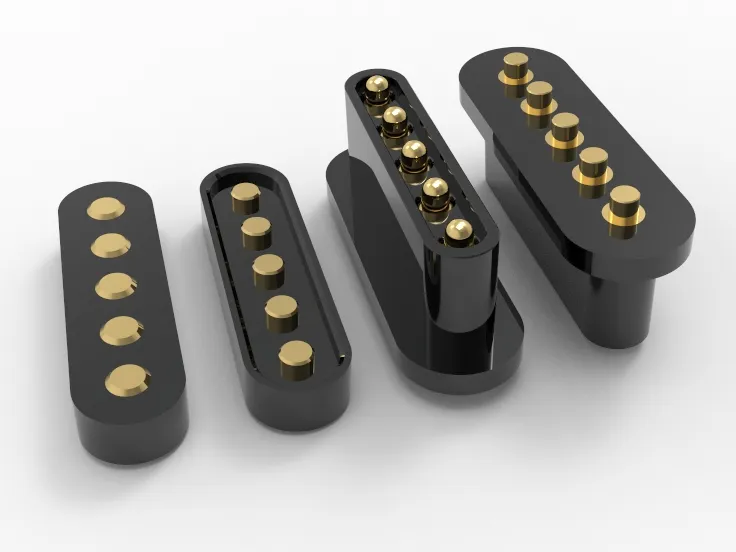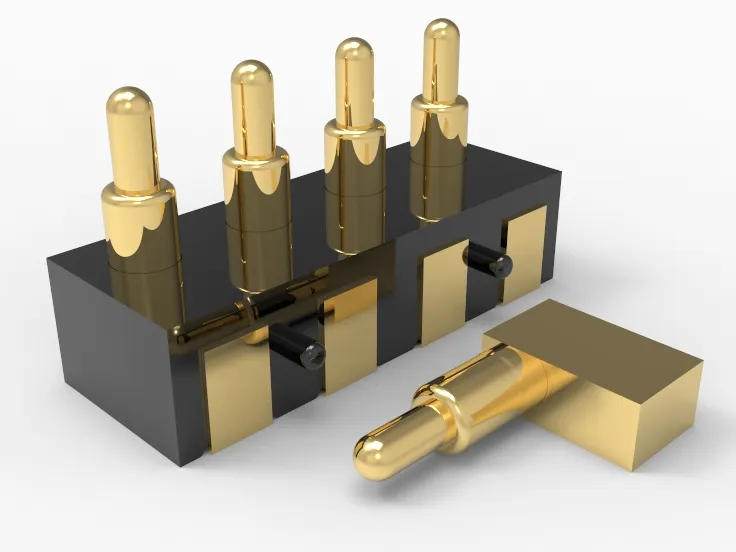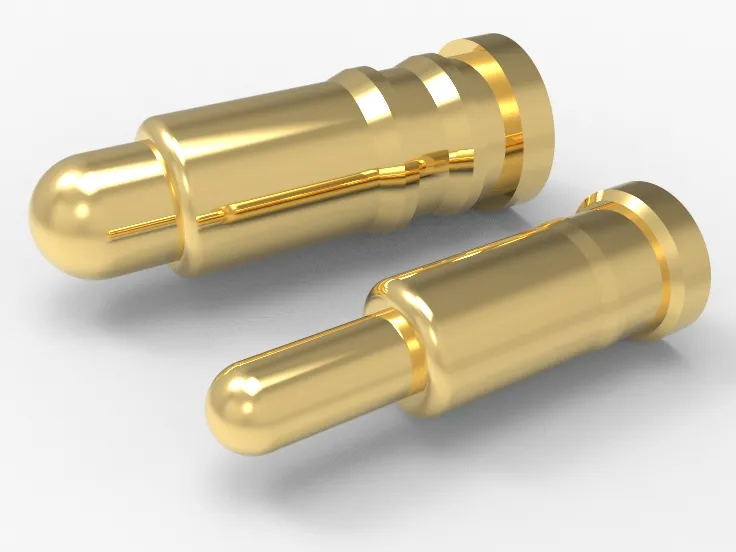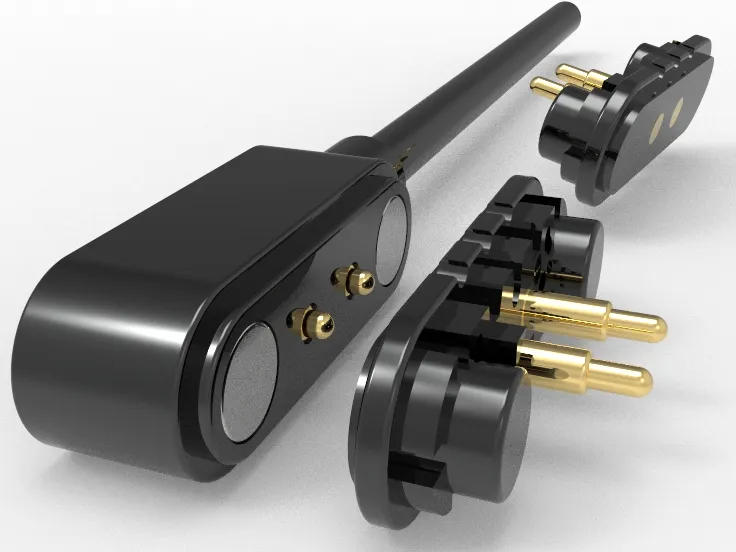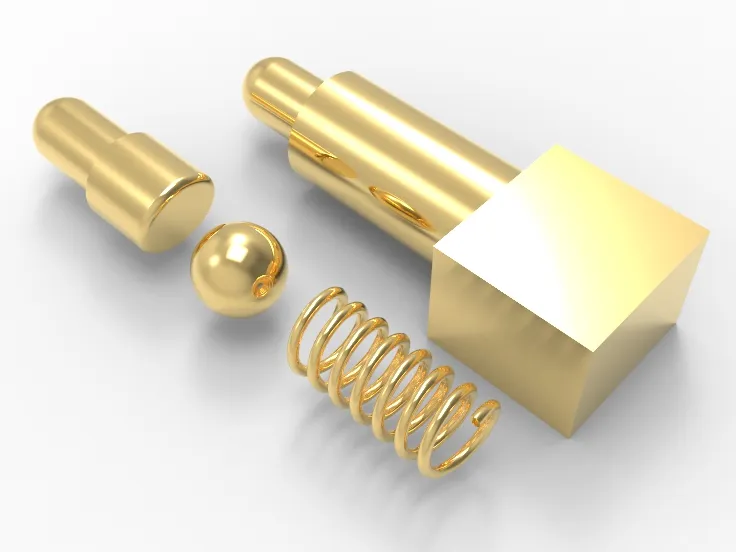Best Plastic Material in Johoty’s Pogo Pin Connector Ensures Top Quality and Low Cost. Discover Various Types and Impacts on High Performance
Introduction
In manufacturing a Pogo pin connector, choosing the right plastic material is crucial. Each material not only affects the product’s performance but also impacts its final cost-effectiveness. This blog will explore the various plastic material used for Johoty’s high-quality Pogo pin connector, analyzing how these material help maintain high standards while keeping manufacturing costs as low as possible.
We’ll look at material like ABS, PC, and PBT from a professional standpoint, revealing their unique advantages in terms of heat resistance, durability, and electrical performance. By the end of this article, you’ll have a comprehensive understanding of how these material affect Pogo Pin Connector performance, helping you grasp the art of balancing product quality with cost.
Overview of Plastic Material
1. Importance of Plastic Material:
- Durability and Longevity: The plastic material used in high-quality Pogo pin connector must offer exceptional durability, maintaining stable performance through frequent use and long-term wear. Selecting the right plastic material can significantly extend the connector’s lifespan, reducing replacement and maintenance costs.
- Corrosion and Chemical Resistance: Pogo pin connectors frequently work in tough settings where they might get exposed to harmful chemicals or wet conditions. High-quality plastic material should resist corrosion and chemical damage, ensuring reliable performance despite environmental factors.
- Excellent Electrical Insulation: To prevent electrical shorts and other issues, the chosen plastic material must provide excellent insulation. This boosts safety and makes sure the electrical signals stay steady.
- Temperature Tolerance and Heat Stability: Pogo pin connector might encounter extreme temperatures in use, so the plastic material must maintain their physical and chemical properties under both high and low temperatures. Good heat stability prevents deformation or failure at high temperatures, ensuring consistent connector performance.
- Mechanical Strength and Impact Resistance: The mechanical strength and impact resistance of plastic material are vital for the connector’s overall structure. High-quality material should withstand physical impacts and mechanical stress, avoiding damage during transport, installation, or use.
- Dimensional Stability and Processability: Plastic material for Pogo pin connector needs good dimensional stability and processability to ensure accuracy and consistency during production. Stable material ensure that every component of the connector fits precisely, enhancing product quality and performance.
- Cost-Effectiveness: Finally, choosing the right plastic material is key to controlling production costs while maintaining high quality. By selecting cost-effective material, manufacturers can produce Pogo pin connector that meets quality standards and remain competitively priced.
2. Material Requirements:
- Insulation Properties: The plastic material must have excellent electrical insulation to prevent current leakage or shorts. High insulation ensures that the Pogo Pin Connector transmits electrical signals safely and stably in various environments.
- Heat Resistance: The material should remain stable at high temperatures without melting, deforming, or aging. Because electronic devices get warm when they run, it’s essential that the plastic can handle that heat.
- Mechanical Strength: The plastic material needs sufficient mechanical strength to endure the friction and pressure of repeated insertions and withdrawals, while also preventing breaking or deforming.
- Chemical Resistance: As Pogo pin connector are often exposed to various chemicals, the material must resist corrosion from acids, bases, solvents, and other substances to ensure long-term stability.
- Processability: The plastic material must be easy to process, allowing for precise injection molding and the creation of complex structures and shapes during production.
- Environmental Compliance: The plastic material needs to follow rules like RoHS and REACH to make sure the product is safe for global markets and friendly to the environment.
- Cost-Effectiveness: The material should be cost-efficient while meeting all the above performance requirements, to keep the Pogo Pin Connector competitively priced in the market.
Common Plastic Material and Their Characteristics
1. Thermoplastics:
Polycarbonate (PC)
- Characteristics: Polycarbonate is a high-strength, transparent thermoplastic with excellent impact resistance and heat tolerance. It maintains stable physical properties within a temperature range of -40°C to 120°C.
- Advantages: Strong and durable with great heat resistance and solid electrical insulation.
- Applications: Used in high-end pogo pin connector, especially where a transparent case or high-impact environment is needed.
Polyamide (PA, Nylon)
- Characteristics: Also known as Nylon, polyamide offers excellent mechanical strength, wear resistance, and chemical resistance, making it ideal for high-wear or high-temperature environments.
- Advantages: Good wear resistance, low friction coefficient, excellent self-lubricating properties.
- Applications: Commonly used for pogo pin connector housings in industrial and automotive settings where wear and corrosion resistance are crucial.
Polybutylene Terephthalate (PBT)
- Characteristics: PBT is a crystalline thermoplastic polyester known for its chemical resistance, mechanical strength, and dimensional stability. Because it doesn’t absorb water easily, it’s ideal for areas that stay humid for extended periods.
- Advantages: High dimensional stability, strong moisture and chemical resistance, excellent insulation properties.
- Applications: Used in electrical and electronic pogo pin connector, especially where long-term stability and weather resistance are needed.
Liquid Crystal Polymer (LCP)
- Characteristics: LCP is a high-performance thermoplastic with high strength and a low thermal expansion coefficient. Its unique molecular structure ensures excellent mechanical performance even at high temperatures.
- Advantages: Excellent dimensional stability at high temperatures, outstanding chemical resistance, flame resistance.
- Applications: Widely used in pogo pin connector requiring high-temperature performance, especially in high-frequency and precision electronic components.
Polyphenylene Ether (PPE)
- Characteristics: PPE is a low moisture-absorbing, high-strength thermoplastic suitable for harsh electrical environments. It provides top-notch electrical insulation and keeps its shape even when exposed to high heat.
- Advantages: Excellent electrical insulation, high-temperature resistance, low moisture absorption, and chemical resistance.
- Applications: Used in pogo pin connector where high electrical insulation is required, such as in power transmission and communication devices.
Polyphenylene Sulfide (PPS)
- Characteristics: PPS is a high-strength engineering plastic material with exceptional heat and chemical resistance. It stays strong even when things get hot and is resistant to flames.
- Advantages: Outstanding heat resistance, stable up to 200°C, excellent chemical stability, strong mechanical properties.
- Applications: Ideal for pogo pin connector in high-temperature environments, such as in industrial automation and aerospace applications.
Polyethylene Terephthalate (PET)
- Characteristics: PET is a crystalline polymer with good mechanical strength and chemical resistance, used in various industrial applications.
- Advantages: High mechanical strength, chemical resistance, good dimensional stability.
- Applications: Used in high-precision, high-reliability pogo pin connector, especially where long-term dimensional stability is important.
2. Thermosetting Plastic Material:
Phenolic Resin
- Characteristics: Phenolic resin offers excellent electrical insulation and thermal stability, with high mechanical strength and chemical resistance. Its toughness and resistance to compression keep it stable in both high heat and high pressure.
- Advantages: High heat resistance, excellent insulation reducing electrical noise.
- Applications: Used in pogo pin connector for high-temperature environments, such as in automotive electronics and industrial equipment.
Epoxy Resin
- Characteristics: Epoxy resin sticks really well, provides great electrical insulation, and resists chemicals effectively. It withstands high temperatures and maintains high strength and rigidity after curing.
- Advantages: Chemical and heat resistance ensure stable performance in harsh conditions.
- Applications: Commonly found in high-performance electronics and precision tools, like computer parts and communication gear.
Polyurethane
- Characteristics: Polyurethane offers excellent wear resistance and elasticity, along with good chemical and oil resistance. Its flexibility helps enhance the mechanical contact performance of connectors.
- Advantages: Buffers mechanical shocks effectively, improving durability and reliability.
- Applications: Suitable for electronic connectors requiring high wear resistance and elasticity, such as consumer electronics and medical devices.
Epoxy Phenolic Resin
- Characteristics: Combining the benefits of epoxy and phenolic resins, this material provides excellent heat resistance and electrical insulation, along with high chemical stability.
- Advantages: Improves stability and durability of pogo pin connector under extreme conditions.
- Applications: Mainly used in electronic applications in high-temperature and high-humidity environments, like aerospace and high-end industrial equipment.
Impact of Plastic Material on Pogo Pin Connector Performance
1. Heat Resistance:
- Heat Deflection Temperature (HDT): This measures how well plastic maintain its shape when exposed to heat. Plastics with a high HDT can keep their shape under high temperatures, preventing deformation of the Pogo Pin Connector and ensuring reliable connections.
- Coefficient of Thermal Expansion (CTE): This explains how a material changes in size when the temperature goes up or down. Plastics with a low CTE help maintain the structural stability of the Pogo Pin Connector and reduce mechanical failures caused by temperature fluctuations.
- Thermal Aging Resistance: This refers to how a plastic material ages under prolonged exposure to high temperatures. Plastic material with good thermal aging resistance remains stable in high temperatures, resisting brittleness and degradation, which extends the lifespan of the Pogo Pin Connector.
- Melting Point: The melting point determines the stability of plastic under high temperatures. Plastic material with a high melting point can withstand higher operational temperatures without melting or softening, ensuring the Pogo Pin Connector functions properly even in hot conditions.
- Thermal Conductivity: This indicates how well a material moves heat through itself. Plastic material with high thermal conductivity effectively dissipate heat, preventing performance decline or damage to the Pogo Pin Connector due to localized overheating.
- Thermal Decomposition Temperature: This is the temperature at which plastic starts to decompose. Plastics with a high decomposition temperature remain stable at high temperatures, avoiding harmful effects on the Pogo Pin Connector from material breakdown.
- Thermal Stability: This refers to how well a material maintains its chemical and physical properties at high temperatures. Plastics with high thermal stability resist chemical reactions and structural changes under heat, ensuring long-term reliability of the Pogo Pin Connector.
2. Electrical Insulation Performance:
- Dielectric Strength: This measures a plastic’s ability to withstand voltage without breaking down. Plastics with high dielectric strength effectively prevent current leakage and short circuits, enhancing the insulation performance of the Pogo Pin Connector.
- Dielectric Constant: This affects capacitance and electrical signal transmission. Plastics with a low dielectric constant reduce signal loss and electromagnetic interference, ensuring stable signal transmission for the Pogo Pin Connector.
- Insulation Resistance: This measures the material’s resistance to electrical current flow. Plastics with high insulation resistance effectively isolate current, reducing leakage and improving electrical insulation performance.
- Moisture Resistance: This is crucial for maintaining performance in humid environments. Plastics with good moisture resistance retain their electrical insulation properties even in high humidity, preventing insulation failure due to moisture.
- Temperature Resistance: The temperature resistance of plastic affects its insulation performance in varying temperature environments. Plastics should maintain stable insulation performance at high temperatures, avoiding material degradation and insulation failure.
- Chemical Corrosion Resistance: The stability of plastic when exposed to chemicals is vital. Plastics with good chemical corrosion resistance prevent chemicals from negatively affecting insulation, ensuring the long-term reliability of the Pogo Pin Connector.
- Mechanical Strength and Wear Resistance: These determine how prone the plastic is to damage during use. Durable plastic material with strong mechanical properties and wear resistance cuts down on damage and ensures reliable electrical insulation.
3. Mechanical Strength:
- Tensile Strength: This indicates how well plastic material withstands stretching forces. Plastics with high tensile strength prevent breaking or deforming during use, maintaining the connector’s mechanical stability.
- Impact Resistance: This refers to the material’s ability to handle sudden impacts or pressure. Plastic material with good impact resistance reduce damage from external forces, ensuring the durability of the Pogo Pin Connector.
- Hardness: Hardness affects a plastic’s resistance to wear. Higher hardness plastic material resists surface wear and scratches, extending the Pogo Pin Connector’s lifespan.
- Elastic Modulus: This reflects how well plastic material maintains its shape under force. Plastic material with high elastic modulus keeps its shape stable under stress, preventing excessive bending or deformation and ensuring proper connector function.
- Temperature Resistance: The temperature resistance of plastic material directly impacts its mechanical strength. Good temperature resistance prevents softening or brittleness under extreme temperatures, preserving the connector’s mechanical strength.
- Chemical Resistance: This determines how well plastic material remains stable after exposure to chemicals. Plastics with high chemical resistance avoid degradation from chemicals, maintaining mechanical strength and stability.
- Aging Resistance: This affects how plastic material holds up over time. High-quality plastic material resists environmental factors like UV and oxidation, reducing aging and strength loss.
Impact of Plastic Material Choice on Costs
1. Material Cost Comparison:
- Raw Material Costs: The basic cost of different plastics is a major factor affecting overall expenses. For instance, engineering plastic material like polycarbonate (PC) and polyamide (PA) is generally more expensive than general-purpose plastic material like polypropylene (PP) or polyethylene (PE). Higher-cost material is often used in Pogo pin connector that require greater durability or specific performance features.
- Production Process Requirements: Some plastics need specific processing conditions, such as higher temperatures or more complex mold designs. These requirements can increase maintenance costs for production equipment and energy consumption, thus raising the final product’s cost.
- Processing Performance: The ease of processing plastic material, including flowability and cooling time, impacts production efficiency. High-performance plastic material like polyoxymethylene (POM) often have better flow characteristics during injection molding, which can reduce production cycles and waste, indirectly lowering costs.
- Durability and Performance Needs: The physical properties of plastic material, such as wear resistance, impact resistance, and chemical resistance, directly affect the lifespan and performance of Pogo pin connector. While high-durability plastic material may have a higher initial cost, they can extend product life and reduce replacement frequency, lowering overall costs in the long run.
- Thermal Stability: Some plastics offer better thermal stability, which is crucial for stable operation of Pogo pin connector in high-temperature environments. High-temperature plastic material like polyimide (PI) can prevent performance degradation in hot conditions, reducing maintenance and replacement costs despite their higher price.
- Recycling and Environmental Costs: Some plastics are more difficult to recycle, which can increase the cost of waste disposal and environmental management. Opting for plastics that are easy to recycle can cut down on waste disposal expenses and help you comply with tougher environmental rules.
- Market Supply and Procurement Stability: The market supply of plastic material can also affect costs. For example, the availability of some plastics may be affected by global market fluctuations, leading to price volatility. This instability can cause fluctuations in raw material costs, impacting the overall production cost of the final product.
2. Controlling Manufacturing Costs:
- Choosing Plastic Material: Opting for stable and relatively low-cost plastic material, such as polyamide (PA) or polypropylene (PP), can effectively reduce production costs.
- Material Flowability: Selecting plastic material with good flow characteristics can reduce mold venting issues, improve production efficiency, and lower defect rates.
- Processing Temperature Control: Optimizing processing temperatures ensures good flowability and curing of plastic material during injection molding, enhancing production stability.
- Optimizing Injection Molding Cycles: Adjusting cycle times to improve production efficiency can reduce the cost per unit produced.
- Mold Design Optimization: Improving mold design, such as using cooling systems and choosing appropriate mold material, can shorten production cycles and enhance product consistency.
- Reducing Waste: Using precision injection molding techniques to minimize material waste helps lower overall production costs.
- Long-Term Durability: Choosing plastic material with high wear resistance can reduce maintenance and replacement frequency, lowering long-term usage costs.
Using High-Temperature PEEK as an Example to Analyze Its Processing Characteristics and Lower the Overall Cost of Johoty’s Pogo pin connector
- High-Temperature Resistance: PEEK can operate reliably at temperatures up to 250°C. Its high-temperature stability reduces the impact on material performance under heat, thus lowering costs related to overheating, damage, and frequent replacements.
- Excellent Mechanical Properties: PEEK offers high strength and rigidity, allowing it to withstand heavy loads without deforming. This reduces wear and failure in the connector during use, which lowers maintenance and replacement costs.
- Chemical Resistance: PEEK stands up well to different chemicals, like solvents, acids, and bases. This property minimizes damage in corrosive environments, extending the Pogo Pin Connector’s lifespan and reducing long-term replacement costs.
- Low Friction Coefficient: The low friction coefficient of PEEK reduces friction loss, which decreases wear on the connector and enhances its durability. This characteristic ensures stable performance under frequent use and reduces maintenance costs associated with friction wear.
- Excellent Electrical Insulation: PEEK provides strong electrical insulation, effectively preventing current leakage and electrical interference. This insulation helps reduce costs associated with electrical failures and repairs.
- Processing Stability: PEEK demonstrates high stability and consistency during processing, which reduces waste during production. This stable processing performance helps lower additional costs caused by material issues during manufacturing.
- Radiation Resistance: PEEK has good resistance to radiation, maintaining its performance in radiation-rich environments. This makes PEEK suitable for specialized applications and reduces material damage from environmental factors, thus lowering overall maintenance and replacement costs.
Conclusion
The choice of plastic material is crucial in the manufacturing process of Pogo pin connector. Different plastics not only affect the connector’s performance but also directly impact its cost and durability. Here are some common plastics and their applications in Pogo pin connector:
- Polyamide (PA, Nylon): Known for its excellent wear resistance and mechanical strength, PA is widely used in Pogo pin connector. It maintains stable performance under frequent contact and offers good temperature and chemical stability.
- Polycarbonate (PC): PC is praised for its excellent durability against impacts and its clear appearance. Even though it costs more, its toughness and heat resistance make it perfect for situations with heavy use and harsh conditions.
- Polyethylene (PE): PE is a cost-effective plastic material suitable for Pogo pin connector with low to medium strength requirements. It provides good electrical insulation and chemical resistance but is slightly less durable and heat-stable compared to other material.
- Polyoxymethylene (POM, Delrin): POM is known for its excellent dimensional stability and low friction coefficient, making it ideal for high-precision and high-load applications. It offers great wear resistance and mechanical performance, making it a top choice for high-quality Pogo pin connector.
- Polyurethane (PU): PU has high elasticity and wear resistance, suitable for Pogo Pin Connector applications that require frequent bending or compression. It also offers good oil resistance and tear strength.
By selecting the appropriate plastic material, Johoty can effectively control production costs while maintaining high quality for the Pogo Pin Connector. Different materials come with their own perks and are ideal for particular applications. Through precise material selection and optimized design, we ensure both high performance and cost-effectiveness for the connectors.
We hope this information helps you understand the impact of various plastic material on Pogo Pin Connector performance. For any additional questions or support, just contact our CFT Team.










